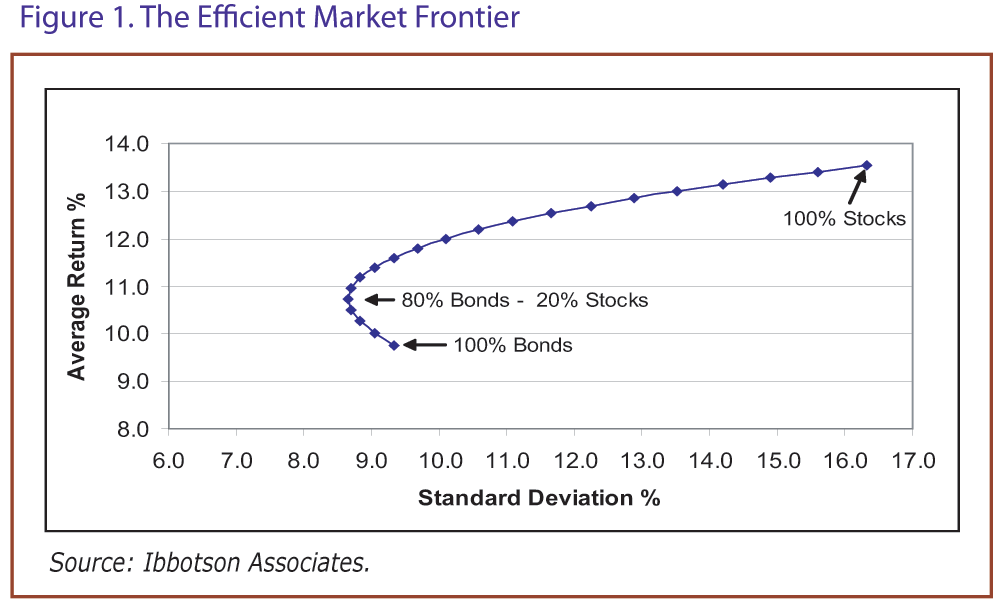By Charles Rotblut | 6 September 2010
There is a secret to investing that many investors are never told: You can achieve higher returns and reduce your portfolio's level of risk at the same time. Yes, you read that right, higher returns and lower risk are both possible. This is not a magic formula designed by someone to sell you a get-rich-quick scheme. Rather, the creator of this strategy was awarded a Nobel Prize in economics.
Modern Portfolio Theory
In 1952, Harry Markowitz wrote an essay titled "Portfolio Selection" that became the basis for modern portfolio theory MPT. Modern portfolio theory holds that when various uncorrelated assets are combined in a portfolio, [[overall, long-term: normxxx]] return is improved and risk is lowered. The risk level of the individual security does not matter as long as its return varies from the other securities in the portfolio. [[Where risk is measured solely as the volatility of a security.: normxxx]]
When constructing a portfolio, you could opt for an extremely low-risk, but unsatisfactory long-term portfolio by holding only short-term government bonds. At the other extreme, you could create a long-term portfolio comprised of only [[extremly volatile: normxxx]] 'high-growth' stocks. Between these two extremes are portfolios that contain just the right mix of assets. In other words, you want a portfolio with assets and securities that complement each other.
The Efficient Market Frontier
Markowitz formulated that there is a line at which a portfolio produces the ideal amount of return for a given level of risk: This is known as the efficient market frontier. It shows whether a portfolio is taking on too much risk for a given a level of return. It can also reveal whether or not a portfolio is achieving a high enough return for the amount of risk it is taking.
Figure 1. The Efficient Market Frontier

Click Here, or on the image, to see a larger, undistorted image.
As you can see in Figure 1, the efficient market frontier is curved. The reason is that there is a point of diminishing performance relative to risk. After a certain point, the amount of additional return diminishes as the level of risk is increased (upper, right-hand end of the line). Similarly, a portfolio that is too conservative does not even generate enough return to compensate for its inherent low risk (lower, left-hand end of the line).
Putting Theory Into Action
The goal for investors is to build a portfolio out of uncorrelated assets and securities— this holds true regardless of your risk tolerance. I will give you two examples. First, investors who are risk-averse will want to allocate the majority of their portfolios to bonds or bond mutual funds. The types of bonds included in the portfolio should have differing maturity dates, varying issuers (Treasury, municipal, corporate, international, etc.) and various credit ratings. A smaller portion of the portfolio should be allocated to other asset classes (e.g., stocks) to provide protection against inflation and periods of rising interest rates.
Second, investors with a higher tolerance for risk will want to allocate the majority of their portfolios to stocks. The equity portion should mix various sectors and industries, styles (growth and value), market capitalizations (small, mid and large), and geographic regions (domestic, Europe, Asia and Latin America). A smaller portion of the portfolio should be allocated to other asset classes (e.g., bonds) to provide protection against bear markets as well as a stream of income.
In both examples, the idea is to lower the risk by combining several different types/classes of securities. This moves the portfolio closer to the efficient market frontier by enabling it to benefit from several market forces instead of just one or two. [[In particular, by having the good effects of one asset class 'balance out' the bad effects of another asset class, at any given time.: normxxx]].
Other Considerations
The examples above used stocks and bonds. A truly diversified portfolio should include other asset classes as well, such as real estate and commodities. In both cases, owning the physical asset (e.g., actual land or bullion) provides more diversification than a real estate investment trust REIT or mining company. (However, a REIT or shares of a mining company would be easier to buy and sell.)
During times of financial distress, correlations of different asset classes can move toward 1.0, meaning they move in the same direction. This occurred during the bear market of 2007–2009. But even when all classes become seemingly correlated, the actual level of loss will differ from the decline that would have been experienced if the portfolio were invested in a single asset class. [[Ie, it should prove less catastrophic than the worst asset class.: normxxx]].
|
ߧ
Normxxx
______________
The contents of any third-party letters/reports above do not necessarily reflect the opinions or viewpoint of normxxx. They are provided for informational/educational purposes only.
The content of any message or post by normxxx anywhere on this site is not to be construed as constituting market or investment advice. Such is intended for educational purposes only. Individuals should always consult with their own advisors for specific investment advice.
No comments:
Post a Comment